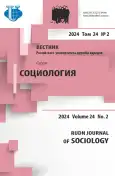New urbanization policy in China: Causes and prospects
- 作者: Barkov S.A.1, Zhang J.2
-
隶属关系:
- Lomonosov Moscow State University
- Нenan University of Animal Husbandry and Economy
- 期: 卷 24, 编号 2 (2024)
- 页面: 379-386
- 栏目: Contemporary society: the urgent issues and prospects for development
- URL: https://journal-vniispk.ru/2313-2272/article/view/323212
- DOI: https://doi.org/10.22363/2313-2272-2024-24-2-379-386
- EDN: https://elibrary.ru/PHDASG
- ID: 323212
如何引用文章
全文:
详细
More than forty years passed since the start of the reform and opening policy in China, which made millions of peasants move to the city. Urbanization has become one of the most important social processes in China, which helped the country gain a powerful economic potential based on the accelerated industrialization. Social-economic development is impossible without the expansion of cities and their populations. Until recently, cities have been centers for developing human capital and ensuring economic growth. However, urbanization has negative consequences as it leads to an outflow of workforce from rural areas, thus threating their social development. To confront such a threat, the Chinese government introduced a new type of urbanization for the simultaneous revival of rural areas. These two national strategies may seem opposite in terms of goals and objectives: the first stategy aims at developing cities and improving urban living conditions; the second strategy aims at developing rural infrastructure; but both strategies have a common goal - to ensure social modernization with Chinese specificity, which implies harmonious development and urban-rural balance. The article aims at identifying social, managerial and economic features of the new urbanization policy in China as a two-pronged strategy of the simultaneous development of urban and rural areas. The implementation of this new type of urbanization is to solve a number of problems of internal migration, since peasants who have not managed to arrange their lives in the city cannot return to the countryside for different reasons. Local authorities of both cities and villages struggle to increase the size of their population, which determines conflicts and ineffective management decisions in many Chinese regions. In many cases, there is a clear discrepancy between the interests of society as a whole and the interests of regional administrative bodies implementing social-economic policies. China needs to solve these problems to ensure sustainable urban development while improving living conditions in rural areas.
作者简介
S. Barkov
Lomonosov Moscow State University
编辑信件的主要联系方式.
Email: barkserg@live.ru
доктор социологических наук, заведующий кафедрой экономической социологии и менеджмента Leninskie Gory, 1-33, Moscow, 119234, Russia
Jie Zhang
Нenan University of Animal Husbandry and Economy
Email: galya66888@mail.ru
преподаватель Института гуманитарных наук и права Zhengzhou, Province Henan, 450004, China
参考
- Cai Jimin. The revival of the countryside is inseparable from the new urbanization. Classics of Global Business. 2018; 3. (In Chinese).
- Chen Meng. Rural rebirth: The other side of urbanization. Ningbo Economics (Finance and Economics). 2018; 3. (In Chinese).
- China National Knowledge Infrastructure. URL: https://cnki.net. (In Chinese).
- Constitution of the People’s Republic of China. URL: http://jspgh.com/djwh/detail.aspx?id=4116. (In Chinese).
- Han Jun. The relationship between rural revitalization and urbanization is either one or the other. Economics of the Environment. 2018; 5. (In Chinese).
- Land Code of the People’s Republic of China. URL: http://www.npc.gov.cn/npc/c30834/201909/d1e6c1a1eec345eba23796c6e8473347.shtl. (In Chinese).
- Lei Ming, Yu Shasha, Lu Ming. Comprehensive revival of rural areas in the perspective of the multidimensional theory. Guansi Social Sciences. 2022; 2. (In Chinese).
- National New Urbanization Plan (2014-2020). URL: http://www.gov.cn/zhengce/2014-03/16/content_2640075.htm. (In Chinese).
- de Soto H. The Other Path: The Economic Answer to Terrorism. Chelyabinsk; 2008. (In Russ.).
- de Soto H. The Other Path: The Invisible Revolution in the Third World. Moscow; 1995. (In Russ.).
- Statement of the Central Committee of the Communist Party of China and the State Council on the Comprehensive Promotion of Rural revitalization in 2022. URL: http://www.lswz.gov. /html/xinwen/2022-02/22/content_269430.shtml. (In Chinese).
- Tang Qiong, Wu Ching. Analysis of problems and proposals for countermeasures to reform the system of registering urban and rural households under the new urbanization. Scientific Development. 2022; 9. (In Chinese).
- Wu Min. A study of the integrated rural revival and new urbanization. Yuanliu. 2022; 4. (In Chinese).
- Xiao Jing, Liu Huagao, Huang Qiang, Sun Yanhong. Logical thinking in planning the revival of rural areas under the urbanization 2.0. Planner. 2022; 7. (In Chinese).
- Xie Tiancheng, Zhang Yan, Wang Yuxuan, Shi Zulin. Coordinated rural revival and new urbanization based on the analysis of spatial-temporal provincial evolution. Economic Issues. 2022; 9. (In Chinese).
- Zhang Jie. Influence of urbanization on China’s social-economic development: Correlation and regression analysis. Sociology. 2020; 5. (In Russ.).
- Zhang Jie. The phenomenon of Chinese “semi-urbanization” and its impact on rural education. Sociology. 2021; 2. (In Russ.).
- Zhang Xin. Promotion of rural revival and coordinated regional development through urbanization. Environmental Economics. 2018; 1. (In Chinese).
- Zhou Wen. A study of the integrated urban-rural development under the new urbanization and rural revival. Review of Political Economy. 2022; 3. (In Chinese).
补充文件









